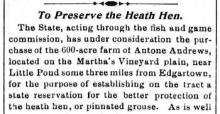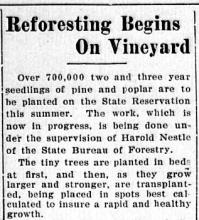A representative of the state Department of Conservation made an investigation on the Island on Friday, in company with Rep. Joseph A. Sylvia, in order to prepare a report on the matter of state purchase of the beach between Oak Bluffs and Edgartown. The sentiment of those who were approached was strongly in favor of the project, which is for purchase of the beach with stipulations that no buildings shall be placed upon it. There seemed no doubt that the preliminary report would be favorable.

From the September 12, 1941 edition of the Vineyard Gazette:
Editorial: Beach Purchase
The first steps have been taken toward bringing about state purchase of the sweeping crescent of beach which lies between Oak Bluffs and Edgartown, along the beach road. Representative Sylvia, in initiating the project, has been careful to stipulate that no buildings shall be erected in case the purchase is consummated. This stipulation is, as a matter of fact, one of the strongest of arguments which can be used with the state legislature to overcome possible objection and opposition. It is unlikely that the state will agree to such a purchase unless there is assurance against pleas for further appropriations for development and maintenance. In this case the assurance is easy to give, for the chief reason for bringing the beach into the public domain is to preserve it unspoiled, and we believe any sort of development would be uncompromisingly opposed.
As in all matters of the kind, it is clear that the attitude of the public - in this case the summer public as well as the year-round public - is important. We believe that the project should be kept in view during its successive phases, and that there should be expressions of interest from those who wish to have the beach open to the public.
There is, we think, no ground for opposition other than the fear that state ownership might lead to concessions of one sort or another. With this possibility effectually guarded against from the start, it seems to us that the measure is wholly desirable and one likely to redound greatly to the advantage of this and future generations.

From the June 7, 1946 edition of the Vineyard Gazette:
Beach Purchase Bill Now Goes to Governor
The bill for the purchase of beach property lying between Edgartown and Oak Bluffs, traversed by the road between these towns, was enacted by both house and senate this week, and is now ready for the governor’s signature.
The bill was introduced by Rep. Joseph A. Sylvia several years ago, and in spite of the wartime conditions he kept the project alive and has now succeeded in having it realized. The aim is to bring into public ownership the extensive beach which has been used more or less by the public for a long period, and makes the beach road one of the finest marine drives in the world.
The property has been owned by the Hart family, who have allowed a large measure of public use but have pointed out that this arrangement could not continue indefinitely. Public ownership had become, in their opinion, the best solution.
Under the terms of the bill, the beach will be acquired by the state and placed under the management of the county. The county will also be charged with maintenance, but the proponents of the project had argued strenuously that the beach should be left in its natural condition. The bill carries an appropriation of $38,000.

From the May 28, 1948 edition of the Vineyard Gazette:
State Acquires Beach Holdings of Hart Realty Co.
Two stretches of Martha’s Vineyard beach, between Oak Bluffs and Edgartown, passed into the ownership of the Commonwealth of Massachusetts on Monday. The first parcel consists of the shore from the end of the Oak Bluffs seawall to the old Harthaven jetty; and the second parcel includes the beach on both sides of the highway from the new Sengekontacket opening to the Edgartown bridge - on one side this beach boarders Vineyard Sound, and on the other Sengekontacket Pond.
Theodore Hart, for the William H. Hart Realty Company, and Arthur Lyman, commissioner of the Department of Conservation, executed the transfer papers. The passing of the title to the state marks the end of long and patient efforts by Rep. Joseph A. Sylvia toward a solution of a problem vitally important to the Island and its visitors.
The open beach, beloved by all who know the Island, has made the highway between Edgartown and Oak Bluffs one of the most beautiful marine drives in the world over a long period of years. Unnumbered people who have enjoyed the beach have never realized that it was privately owned, and the Hart family holders of the title to much of the land, have been generous in allowing its use and enjoyment by the public.
Attitude of the Harts
This state of affairs could not continue indefinitely, however, especially with the increasing value put upon the whole property by the public. The attitude of the Hart Realty Company was that if the beach were to be dedicated to the public, it should be purchased for this use; but if the public, either through state or county means, did not care to purchase it, then the ordinary course of private ownership would necessarily follow.
In May 1943, the legislative committee on conservation held a hearing at Edgartown at which representatives of the Island went on record strongly in favor of preservation of the beach in its natural state, without buildings or exploitation of any kind. Representative Sylvia presented the case for his bill to have the state buy the beach.
“The first consideration,” he said, “is to leave this beach and this entire drive in identically the same state that it now is.” He emphasized the beauty, cleanliness and value of the beach and the extent to which it was enjoyed.
The committee made a unanimously favorable report, but the bill was put over until the following year. In 1944 Raymond J. Kenney, then commissioner of conservation, recommended the project, including the transfer of forty-two acres, at a cost of $37,000. The war continued to retard the whole matter, however, and in 1945, A. K. Sloper, new commissioner of conservation, inspected the beach and recommended it.
The bill was finally passed and signed by the governor in 1946. It provides that the county is to manage the beach and to pay the cost of maintenance, the promise being that the present natural state is to be preserved.









Comments